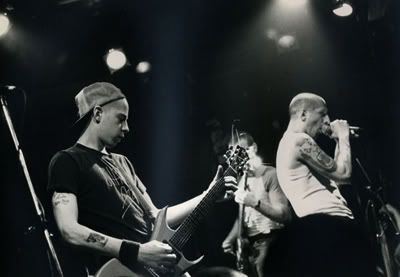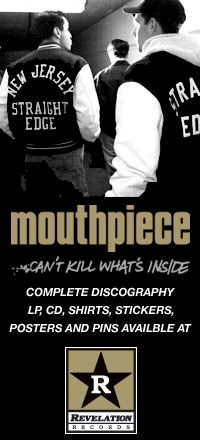
Natalie and Jimmy Gestapo, Sunday matinee CBGB, NYC, Photo: Bri Hurley
Bri Hurley took some incredible NYHC photos and also did the Making A Scene book - a must have for all diehards. Here's the scoop about the girl behind the camera. Hopefully more to come, big thanks to Bri! -Gordo DCXX
I grew up in California. First at Esalen Institute, Big Sur, then later at Gate 6, Sausalito (with a little moving around in between). Both places were filled with live music, from the drums of Babatunde Olatunji, to Joan Baez, to the dirty rock 'n roll of the Red Legs. But I'm sure you mean, when did I get involved with hardcore, punk music. I had a friend in High School who was very much into the punk scene in San Francisco. I went out with her a few times, but it didn't quite stick. It was when I moved to NYC, that I got into this myself.
Before I was involved with photography, I was involved with the arts. I got interested in photography through my experience with theater lighting. Black and white photography "sees" the light and shadow, nothing more or less. I took a basic photo course at Marin Community College, the semester before I went to the east coast. This is the sum total of my formal photography training.
Before NYC, I had a job offer to be the master electrician's assistant at a summer stock theater in Westport, CT. The job was pretty dreadful. The work was great but my boss, not at all. It wasn't until the accident that I had at work in the lighting rental house in NYC, that my focus fully turned to photography.
I built a darkroom in my basement flat, found someone selling everything I needed and spent all my money and much of my time behind the lens or in the dark.
At that same time, I was photographing other subjects as well as the hardcore music scene.
Shooting musicians was sort of an obvious thing for me, having a background that included music and dance. Musicians repeat the same movements and patterns, so it's just a matter of waiting for the moment. Shooting at CBGB's was ideal. I didn't like to shoot with a flash. Being in a club where the lights were close to performers gave me more to work with.
War Zone "Lower East Side Crew" EP cover photo, Todd Youth and Raybeez at CBGB, Photo: Bri Hurley
But the interface with music and photography...well it was all visual. I was often so focused on the visuals that I didn't even hear the music. Shooting on the street in front of the club, I was so focused on the visual that when people spoke to me, I actually couldn't speak. I didn't have the facility to shoot and speak for a long time. I'm sure this had some effect on how people perceived me.
As far as my actual introduction to the NYHC scene, I had a neighbor on Norfolk St., Charley Sclafani, drummer for Ultra Violence. He invited me to a hardcore matinee to shoot his band. Told me I was on the guest list. When I got there, Ken Sly, the door man, thought I was trying to scam him, when I was just clueless. He shouted, "There is no guest list!" So I paid.
The energy, the motion, the chaos and the wave of sound...it all hooked me in.
My interest was really in the rich visuals. A lot of people were suspicious of me. A new comer who arrives with a camera is usually suspect. I expected this, having grown up in alternative communities. I was very aware of coming into a place where people knew each other and they had a common bond. The music was the obvious, but it was also larger than the music. Conventional life/society/culture chaffed. They wanted something that wasn't on offer. They had to make it themselves and they did. I have great respect for this.
With my 'alternative' upbringing, I didn't fit into the conventions either. I knew that there were alternatives and that often you had to create your own. But I had gone through this discovery process some time before. I didn't feel the need for a group. The group dynamic was also something strange for me as I had grown up so much by myself and very self contained.
So, I was just there. I felt like I was standing in rising, fast moving water but never actually got wet. This was the illusion.
I did my utmost to be respectful of the people I was shooting. That was important to me and still is.
There is a hazard being behind the camera. It's the position of an observer and chronicler, and it changes things. Between this, having difficulty speaking and being rather a loner, I'm sure my demeanor didn't encourage people.
The photography was quite a compulsion. I didn't set out to take pictures for a book. I just took pictures of what interested me.
Carl "The Mosher" with Underdog at CBGB, NYC, Photo: Bri Hurley
Wednesday, February 2, 2011
Bri Hurley - Making A Scene
Subscribe to:
Post Comments (Atom)



9 comments:
You guys have to get her to let you run outtake photos from Making a Scene!!! She has tons apparently.
I think Bri might have some opportunities in the future that she's possibly saving those outtake shots for. We'll see what happens, let's keep our fingers crossed. -Tim DCXX
did she say she might have another edition of the book coming out?
I find it it funny she grew up at the Esalen Institute. I almost had a job there. That is a famous hippy commune.
This is one of the coolest interviews yet. Also, Babatunde Olatunji is ILL.
Flattered to be on the cover but had to buy my own copy!
Jimmy G
Hey Jimmy, sorry about you having to buy your own copy. The publishing company gave me exactly 10 copies. They went to my family and the people who helped me put the book together (transcribing, veloxes...).
So basically, everyone bought their own copy except Jana from PMS who wrote me a bad check at the release party. I paid for hers.
I have 2 copies. Sure wish I had more!
Jason, Esalen was never a commune. Sorry to disappoint you. Just another myth, like all hardcore/punks were druggies, thieves and riot starters.
Sure, there were hippies there. Hippies were the underground, rebellion of the time... Your predecessors.
It was a functioning center for groundbreaking psychological thought to be taught, expanded and created. Most of the pop-psychology that you know of came from that time and place, even if it is watered down and simplified almost to into non-existence.
There was no big house where everyone lived together in typical commune fashion. It was business whose aim was psychological growth and personal enlightenment. The jobs that were created there helped artists to live by their work, without selling out, as well as to support the innovative thinkers who were really not welcome in the main-stream psychological world.
It was a different generation's alternate lifestyle. One that changed history, affected people all over the world and that people are still following today... You know, a little like the Hardcore scene ;-)
But no commune.
PS. Thanks for the comments...
Post a Comment